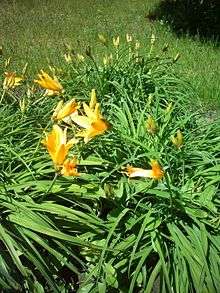Hemerocallis middendorffii
| Hemerocallis middendorffii | |
|---|---|
 | |
| Hemerocallis middendorffii var. middendorffii | |
| Scientific classification | |
| Kingdom: | Plantae |
| Clade: | Angiosperms |
| Clade: | Monocots |
| Order: | Asparagales |
| Family: | Asphodelaceae |
| Subfamily: | Hemerocallidoideae |
| Genus: | Hemerocallis |
| Species: | H. middendorffii |
| Binomial name | |
| Hemerocallis middendorffii | |
Hemerocallis middendorffii, known as Amur daylily,[1] is a plant species in the subfamily Hemerocallidoideae of the family Asphodelaceae of the order Asparagales. It is native to the Russian Far East, northwest China, Korea, and Japan. It grows in meadows, mountain slopes, open woods, and scrub. It is cultivated in Asia for its edible flowers.
Description
Herbaceous perennial with linear arching leaves to 60 cm. Flower scapes 20–90 cm. Flowers 5–6, golden yellow to clear orange, large in a terminal head. Flowers in July for 2–3 weeks and often reblooms in September.[2]
Two varieties are recognized:
- var. middendorfii: To 90 cm. Flowers orange, odorless with elliptic to spathulate tepals. Bracts ovate, 2–2.5 cm. The range of the species.
- var. longibracteata Xiong: 20–35 cm. Flowers yellow, fragrant with lanceolate tepals. Bracts ovate-lanceolate, 3–6 cm. Endemic to China.
Cultivation
Easily cultivated on moist soil in a sunny site, but can tolerate poor soil and partial shade. Propagated by division and by seed. Takes 2–3 years to flower from seed. Plants prefer a neutral to slightly acid soil and will suffer in very acid or alkaline soils. Generally free from pests and diseases. Hardy to USDA zone 4.
References
- ↑ "Hemerocallis middendorffii". Natural Resources Conservation Service PLANTS Database. USDA. Retrieved 14 May 2015.
- ↑ "Flora of China: Hemerocallis middendorffii". efloras.org. Retrieved 29 December 2014.